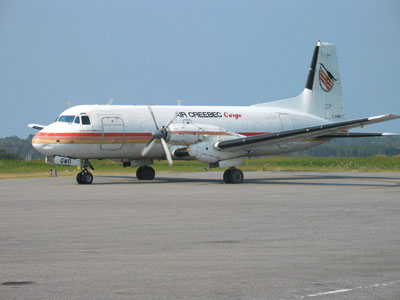
Features
Operations
At The Gate: Depending on development
Since its founding in 1982, Air Creebec has depended heavily on northern development, mostly mining, forestry and Hydro-Québec, for its growth.
March 6, 2013 By Brian Dunn
Since its founding in 1982, Air Creebec has depended heavily on northern development, mostly mining, forestry and Hydro-Québec, for its growth. The Val d’Or, Que.-based airline owned by the Cree nation saw a niche market to serve the north and has taken the ball and run with it.
 |
|
| “Val d’Or is the most prosperous city in Quebec and that’s where Air Creebec does a lot of business.” PHOTO: John Farrington, Air Creebec
|
“There was a need for an airline to serve isolated communities because the only way to get to them was by seaplane,” Matthew Happyjack, president and CEO of Air Creebec, told Wings.
The seeds were planted in 1979 following ratification of the James Bay and Northern Quebec Agreement when the Cree Regional Authority saw a unique opportunity to extend its activities to the field of transportation. The Cree Nation was a promising market and needed a carrier to meet its expectations.
In the spring of 1979, the Grand Chief of the Cree Nation of Quebec and Austin Airways of Timmins, Ont., held their first of several meetings, which eventually led to the creation of Air Creebec. At the start of operations, 51 per cent was Cree-owned and 49 per cent was owned by Austin Airways. In 1988, the Cree bought out their partner’s share of the business, making it the largest commercial transaction ever completed by Canada’s aboriginals.
At the time, Nordair and Quebecair had a near duopoly serving northern Quebec, but CP Air absorbed the two in 1986, leaving a void that Air Creebec gladly filled.
Last fall, on its 30th anniversary, Air Creebec inaugurated a new $10-million hangar and terminal at Dorval’s Pierre Elliott Trudeau International Airport with a $1.3-million subsidy from Quebec. The airline had anticipated a boom in northern development long before former premier Jean Charest announced his Plan Nord in 2011, an ambitious project that calls for public and private investment of an eventual estimated $80 billion by 2036 to open up Quebec’s huge northern region to mining, renewable energy and forestry projects.
With the Parti Québecois now in power, the future of Plan Nord is still very much up in the air. But even before Plan Nord was announced, investment was pouring into mining development in northern Quebec at a rate of nearly $1 billion a year, employing 10,000 people in the region with 11 major mining projects in various stages of development. And all these projects need transportation to move workers in and out of the area and this is why Air Creebec feels, “the sky’s the limit” when it comes to future growth, said Happyjack.
Val d’Or is the most prosperous city in Quebec and that’s where Air Creebec does a lot of business, he added. It has bought three de Havilland Dash-8 35-seaters in the past two years and is adding another. Its fleet of 16 aircraft consists of Dash-8 100 and 300 aircraft, Beechcraft 1900 D and King Air, Embraer 110 and two Hawker 748 Series cargo planes. Each aircraft averages 1,800 flights per year, according to Happyjack.
The airline carries about 60,000 passengers a year, with service divided equally between scheduled and charter flights. The number of destinations it serves is hard to pin down, said Happyjack, because an aircraft can touch down in a village one day to pick up or let off passengers working on a company project and not go there again for months. But the carrier has four main centres, in Dorval, Val d’Or, Timmins and Moosonee, Ont., and 15 destinations listed on its website. While the bulk of Air Creebec flights are in Quebec the airline is also active in northern Ontario.
Happyjack said that the company bought the new Dorval facility last year to accommodate the expected growth in traffic over the next few years. Revenues are roughly $70 million a year and each year is better than the previous one.
A big part of Air Creebec’s growth since 1996 is from the charter half of the business. Goldcorp is Air Creebec’s largest single customer, a position formerly held by Hydro-Québec. But the utility is finishing up its Eastmain project, so business there is slowly diminishing. However, Air Creebec expects to pick up new business from Hydro-Québec’s other project, La Romaine. Another large customer is De Beers, the diamond company that operates a mine near Attawapiskat, Ont.
What’s next for Air Creebec? Happyjack has his sights set on Manitoba and possibly beyond. It’s a resourceful approach, perfect for a company thriving in Canada’s northern resource-based sectors.
Brian Dunn is a Wings writer and columnist.